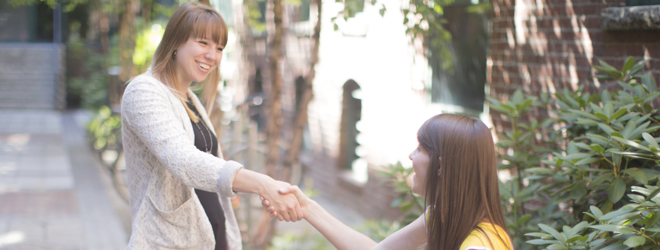
nice to meet you (without the elevator pitch)
A few weeks ago, I encouraged you to hang out with your role models in order to experience the reality of the life or career change you’re seeking to make. Once you’ve discovered the groups or places online and participated or followed the discussions, activities and insights there, you know what comes next. You have to go out and do it in person.
It’s one of the most common fears I hear. What will they think of me? They’ll think I’m a fraud or a wannabe. What will I say?
First – no one is an expert at the start of their journey, we all need to start somewhere. Just like your role model did.
Second – you are a potential wannabe. Just like your role model was.
Third – say what you comes naturally, when you meet new people. Just like your role model is, a new person.
My plea is please please please don’t fall into the trap of the over practiced, cliched 60 second elevator pitch. You know the ones, the slightly mind numbing, so rehearsed that all emotion and passion is sucked out of it.
I say you can do better and thanks for my wonderful role model, Heather White of Smarter-Networking, I know a better way.
Start with purpose
What do you want to achieve from this conversation or introduction? Knowing this will help you match your introduction to your aims.
Think back
Remind yourself that you have conversation all the time with different people. Information is passed, jokes are made, relationships built. You can do this.
Check your options
Are you more comfortable initiating conversation or responding?
Option 1: Wait to be asked then give your name, why you’re there and what you’re about. Remember to finish by asking a question back.
Option 2: Start with “I don’t think we’ve met yet, I’m … insert your name……”. The natural reaction is for the other person to introduce themselves and you’ll be able to follow their example.
Then the conversation flows from there. Stuck for small talk? Try these:
- ask if they’ve been to this event before
- ask who they came with
- comment on the speaker or event topic and ask their thoughts
- explore their work (Who? What? Where?)
- make sure you know the headlines of the day (stay off anything controversial)
- suggest going to the drinks table or bar to get a drink.
Leave with style
When it’s time to go your separate ways, revisit your purpose – did you achieve it or is now the time to ask for a further coffee, their business card or a piece of advice? (Remember this is like a first date, no a wedding proposal!)
That’s my way of beginning conversations at events, I’m intrigued – what’s yours? Share your technique to introducing yourself with style in the comments.






Daniela • September 25, 2014
i tend to do two things. If its an event in which each person gets up and gives their 60 second pitch, then I just try to make it simple enough for a 10 year old to understand, but also enough mystery that they want to ask me more. If its an networking event in which we are meeting lots of new people at once, I try to find something we have in common and talk about that. I like to break the ice. Once they are comfortable, I find that when they ask what I do, they generally care to know because they already like me as a person.
Sarae • September 28, 2014
I love your idea of making others comfortable first – it’s one of the key ways to build trust as you demonstrate your interest and care for others you build intimacy and credibility, whilst diminishing self interest. Thanks for sharing!